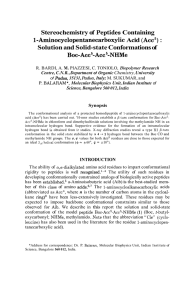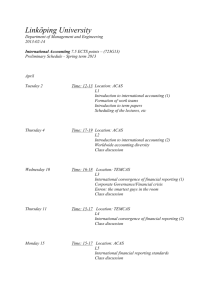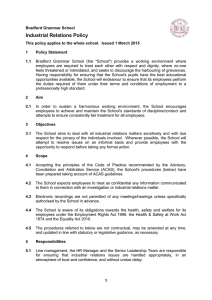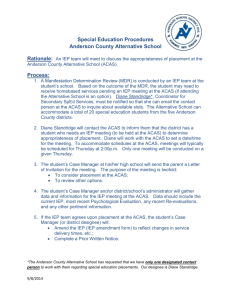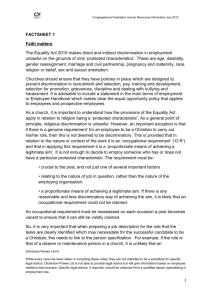Stereochemistry Peptides Containing Acid Am5)
advertisement
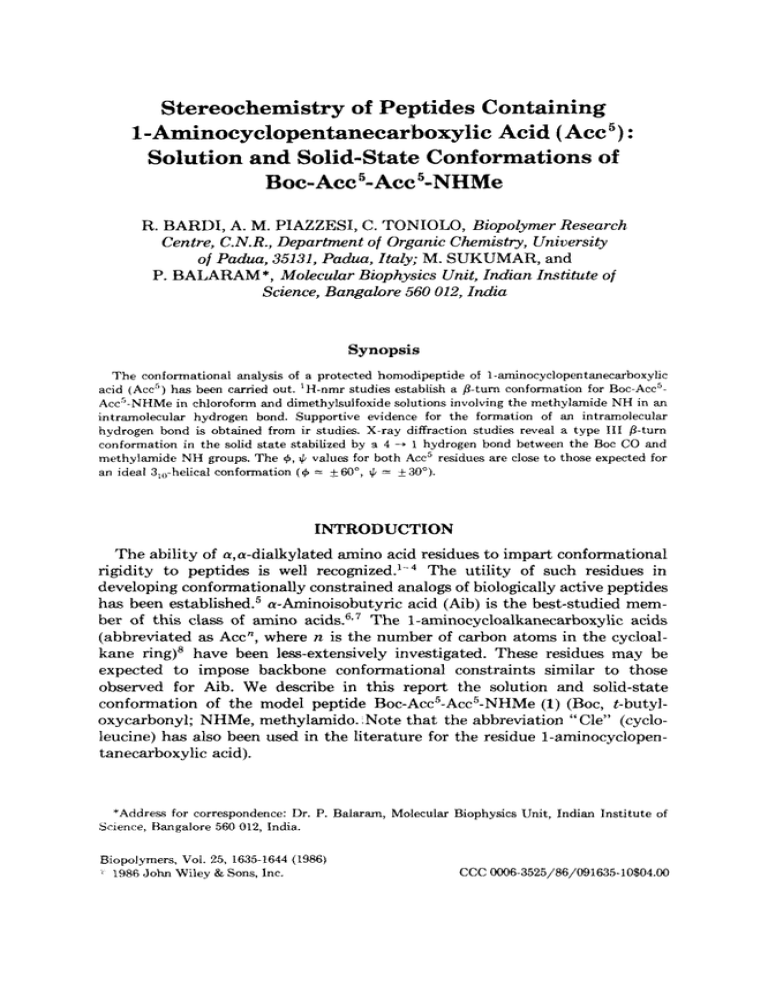
Stereochemistry of Peptides Containing 1-AminocyclopentanecarboxylicAcid ( Am5): Solution and Solid-state Conformations of Boc-Acc'-Acc'-NHMe R. BARDI, A. M. PIAZZESI, C. TONIOLO, BiopoZymer Research Centre, C.N.R., Department of Organic Chemistry, University of Padua, 35131, Pa&, Italy; M. SUKUMAR, and P. BALARAM*, Molecular Biophysics Unit, Indian Institute of Science, Bangalore 560 012, India Synopsis T h e conformational analysis of a protected homodipeptide of 1-aminocyclopentanecarboxylic acid (Acc5) has been carried out. 'H-nmr studies establish a p-turn conformation for Boc-Acc'. Acc'-NHMe in chloroform and dimethylsulfoxide solutions involving the methylamide NH in an intramolecular hydrogen bond. Supportive evidence for the formation of an intramolecular hydrogen bond is obtained from ir studies. X-ray diffraction studies reveal a type I11 p-turn conformation in the solid state stabilized by B 4 + 1 hydrogen bond between the Boc CO and methylamide NH groups. The +, values for both Ace5 residues are close to those expected for an ideal 3,,,-helical conformation ( $ = f60", = k30"). + + INTRODUCTION The ability of a,a-dialkylated amino acid residues to impart conformational rigidity to peptides is well rec~gnized.l-~ The utility of such residues in developing conformationally constrained analogs of biologically active peptides has been establi~hed.~ a-Aminoisobutyric acid (Aib) is the best-studied member of this class of amino acid^.^.^ The 1-aminocycloalkanecarboxylicacids (abbreviated as Accn, where n is the number of carbon atoms in the cycloalkane ring)8 have been less-extensively investigated. These residues may be expected to impose backbone conformational constraints similar to those observed for Aib. We describe in this report the solution and solid-state conformation of the model peptide Boc-Acc5-Acc5-NHMe(1) (Boc, t-butyloxycarbonyl; NHMe, methylamido. ,Note that the abbreviation "Cle" (cycloleucine) has also been used in the literature for the residue l-aminocyclopentanecarboxylic acid). *Address for correspondence: Dr. P. Balaram, Molecular Biophysics Unit, Indian Institute of Science, Bangalore 560 012, India. Biopolymers, Vol. 25, 1635-1644 (1986) 1 1986 John Wiley &Sons, lnc. CCC 0006-3525/86/091635-10$04.00 BARD1 E T AL. 1636 MATERIALS AND METHODS Synthesis of Peptides H-Acc5-OMe . HC1 was prepared by the thionyl chloride-methanol procedureg (yield 95%). Neutralization of the methyl ester hydrochloride with Na,CO, solution, followed by extraction with CHCl, and evaporation of the organic solvent, yielded H-Acc5-OMe,which was used immediately. Boc-Acc5OH was prepared by a standard procedure." Boc-Am5-Ace5-OMe 500 mg (2.1 mmol) Boc-Acc5-OHwas dissolved in 3 mL CH,CI, and cooled in an ice bath. H-Acc5-OMe,extracted from 540 mg (3 mmol) of H-Acc5-OMe . HCl was added, followed by 500 mg of dicyclohexylcarbodiimide (DCC). The reaction mixture was stirred a t room temperature for 12 h and the precipitated dicyclohexylurea was filtered. The filtrate was diluted with 100 mL ethylacetate and washed with 1N NaHCO, (3 x 20 mL), 1 N HCI(3 x 20 mL), and water. The organic layer was dried over anhydrous Na,SO, and evaporated to yield Boc-Acc5-Acc5-OMeas a solid of high purity, as judged by thin-layer chromatography (TLC). Yield: 595 mg (77%).mp: 140-141°C. Nmr (CDCI,): 6 1.36 [s, 9H, C-(CH,),]; 6 1.64, 2.00, 2.20 [m, 16H, CpH,, CYH, Acc5(1) and Acc5(2)]; 6 3.6 (s, 3H, COO-CH,); 6 6.16 [s, lH, NH-Acc5(1)]; 6 6.60 [s, lH, NH-Acc5(2)]. Boc-Acc5-A cc5-NHMe 250 mg of Boc-Acc5-Acc5-OMewas dissolved in 10 mL of dry methanol and saturated with dry CH,NH, gas. The solution was kept tightly stoppered for 3 days a t room temperature. Conversion to the methylamide was established by TLC. Evaporation of methanol yielded a white solid, which showed the presence of traces of the starting material, by TLC. The crude product was chromatographed on a silica gel column (eluent 98 :2 CHC1,-MeOH) to yield Boc-Acc5-Acc5-NHMeas a white crystalline solid. Yield: 200 mg (84%). mp: 6 1.75, 1.95, 2.25 167-168°C. Nmr (CDCI,) (Fig. 1): 6 1.4 [s, 9H, C-(CH,),]; [m, 16H, CPH,, CYH, Acc5(1)and Acc5(2)]; S 2.75 (d, 3H, NH- -3CH )- 6 5.00 [s, l H , NH Acc5(1), 6 6.3 (s, lH, NH Acc5(2)]; 6 7.25 (broad multiplet, lH, NH-CH,). __ Spectroscopic Studies 'H-nmr spectra were recorded on a Varian FT-80A spectrometer. Sweep widths of lo00 Hz were employed, with a digital resolution of 0.244 Hz/point. All chemical shifts are expressed as 6 (ppm) downfield from internal tetramethylsilane. The nitroxide, 2,2,6,6-tetramethylpiperidine1-oxyl was obtained from Sigma Chemical Company. Ir absorption spectra were recorded in dry CHCl solutions on a Perkin-Elmer model 297 spectrophotometer, using cells of pathlength 3.5 mm. , Acc5 PEPTIDES 1637 X-Ray Diffraction Single crystals of 1 (Cl,H31N304) in the space group, P2,/a [ Z = 4, a = 12.100(3), b = 17.247(3) c = 11.143(3) A, /I= 117.5(1)"], were grown by slow evaporation from a methanol-water mixture. X-ray diffraction data were collected on a Philips PW 1100 four-circle diffractometer using M,K, radiation ( A = 0.71069 A). 2019 reflections with I 2 3 4 I)were used in the solution of the structure by application of the direct-methods program MULTAN 80.l~ The E-maps of the set of phases with the best-combined figure of merit revealed the position of 20 nonhydrogen atoms. The positions of the remaining nonhydrogen atoms were derived from subsequent difference Fourier maps. The structure was refined by full-matrix least-squares procedures, with isotropic temperature parameters for all atoms to an R factor of 0.161. At this stage a difference Fourier map revealed disorder of one cyclopentane ring (hereafter called ring 11)-i.e., C(12), C(13), C(14), C(15), and C(16). Population parameters were applied to C(15) and C(150) carbon atoms of ring 11. Refinement with population parameters of 0.650 and 0.350 for C(15) and C(150), respectively, resulted in a change of the thermal parameters to values in accord with those of other carbon atoms. The structure was refined by a TABLE I Fractional Coordinates ( x 10 ), Population Parameters, and Equivalent Isotropic Temperature Factors (Az x lo3) for Boc-Acc5-Acc5-NHMea Population parameter Atom X 1.0 1.o 1.o 1.o 1.o 1.o 1.o 1.o 1.o 1.o 1.o 1.o 1.o 1.0 1.o 1.o 1.o - 258 (3) 1695(3) 3104 (3) 3353 (3) 440 (3) 1198 (3) 2539 (4) 749 (5) - 1555 (5) - 250 (6) - 288 (5) 713 (4) 1414 (4) 2386 (4) 1808 (6) 999 (6) 816 (4) 1987 (4) 1605 (4) 465 (5) 25 (6) 826 (9) 1233 (9) 2037 (5) 2608 (4) 3333 (5) 1.o -~ 1.o 1.o 1.o 0.65 0.35 1.o 1.o 1.o ~~~~ ~ Y 9362 (2) 9070 (2) 7305 (2) 7815 (3) 8158 (2) 7495 (2) 8660 (3) 10641 (3) 10444 (3) 10066 (3) 10146 (3) 8881 (3) 7559 (2) 7718 (3) 7404 (4) 6752 (4) 6784 (3) 7450 (2) 7372 (3) 7462 (4) 6652 (4) 6065 (5) 6190 (5) 6530 (3) 7969 (3) 9310 (4) ~ 'Estimated standard deviations are given in parentheses. hTemperature factors for atoms having partial occupancy factors. z 8295 (3) 8610 (3) 8801 (3) 5707 (4) 8825 (4) 7041 (4) 6626 (5) 8768 (6) 7522 (6) 6413 (6) 7752 (5) 8587 (5) 9332 (5) 10784 (5) 11646 (6) 10892 (6) 9447 (5) 8359 (5) 6000 (5) 4574 (5) 4061 (6) 5179 (10) 4602 (10) 6000 (6) 6146 (5) 6697 (7) BARD1 ET AL. 1638 block-matrix least-squares procedure. The scattering factors were taken from the International Tables for X-ray Crystallography.” The refinement was carried out, allowing all nonhydrogen atoms [except C(15) and C(15O)l to vibrate anisotropically, while hydrogen atoms [except those as C(15) and C(150)] were put in calculated idealized positions (C-H, N-H = 1.0 and were included in the last cycle. Calculations were canied out using the SHELX-76 program.13 The final conventional R value for 2019 observed reflections [ I 2 3 4 I ) ] was 0.0815 ( R , = 0.0745). The final positional parameters of the nonhydrogen atoms, along with equivalent isotropic thermal factors, are listed in Table I. Anisotropic temperature factors, hydrogen positional parameters, and structure factor tables are available from Dr. R. Bardi. A) RESULTS AND DISCUSSION NMR Studies Figure 1 shows the 80 MHz ‘H-nmr spectrum of 1 in CDCI,. The assignment of the three NH groups is straightforward. The singlet a t 4.98 6 corresponds to the Acc’(1) NH (urethane) by virtue of its high-field position. The singlet a t 6.35 6 is due to the Acc5(2)NH, while the broad quartet a t 7.29 i 9 I I I 8 7 6 I S 1 i 1 3 : 1 1 Fig. 1. 80-MHz ‘H-nmr spectrum of Hoc-Acc5-Accs-NHMe in CDCI,,. Inset: effect of addition of the free radical TEMPO on peptide NH resonances. TEMPO concentrations (9%) are indicated against the traces. Acc5 PEPTIDES 1639 r 20 t - N I 10 \ 2. U : Q 0I 0 Acc5!2 I-NH I ; 4.5 30 30 5c 10 20 TEMPO i%)x 10' 10 %( CD3I2SO Fig. 2. Left: effect of increasing concentrations of TEMPO on NH resonance linewidths. A A U , , ~ is the line-broadening induced. Right: solvent dependence of NH chemical shifts in C DCI .,-(CD, ) 2 S 0 mixtures. 6 is assigned to the methylamide NH group. The involvement of NH groups in intramolecular hydrogen bonding was probed using the following methods'*: (I) paramagnetic radical-induced line-broadening in CDCl 3, ( 2 ) solvent depenmixtures, and (3) temperadence of NH chemical shifts in CDC1,-(CD,),SO ture dependence of NH chemical shifts in (CD,),SO. Figure 1 (inset) shows the effect of the addition of the free radical 2,2,6,6-tetramethylpiperidine-l-oxyl (TEMPO) on the linewidth of the NH resonances in 1. The results of these experiments and the solvent dependences of NH chemical shifts are summarized in Fig. 2. The urethane NH, Acc5(1)NH, is clearly solvent exposed since it shows large changes in chemical shifts and linewidths in the solvent and free radical perturbation experiments. The behavior of the Acc5(2) and methylamide NH groups in these experiments is characteristic of solvent-shielded NH protons.14 In (CD,),SO the following temperature coefficients ( d G / d T ) were obtained: Acc5(1) NH 0.0035, Acc5(2) NH 0.003, and NHMe 0.0015 ppm/K. The results suggest that the methylamide NH group is inaccessible to the solvent. The relatively low dS/dT values for the other two NH groups may be a consequence of steric shielding by the bulky, cyclopentyl groups. The presence of intramolecularly hydrogen-bonded conformations is evident from ir absorption studies in CHCl, solution.'5~'6 A v N H (hydrogen-bonded) band a t 3390-3400 cm-' and a v N H (free) band a t 3440-3450 cm-' are observed over the concentration range 5 X 10-3M-0.7 x 10-4M. The relative intensities of these bands is almost constant over this range of peptide concentration. It is noteworthy that the hydrogen-bonded NH-stretching frequency is significantly higher in 1 than that observed in several /%turn pep tide^.'^,'^ A structure compatible with the nmr data would involve the NHMe group in a 4 --* 1 hydrogen bond with the Boc CO group, stabilizing a p-turn conformation. Clear support for such a possibility is obtained by x-ray diffraction studies. 1640 BARD1 ET AL. c15 Fig. 3. Perspective view of the molecular conformation of Boc-Accs-Acc5-NHMein the solid state. Crystal Structure The molecular structure of Boc-Acc5-Acc5-NHMe(I)in the solid state, with the atomic numbering scheme, is shown in Fig. 3. Bond lengths and bond angles are given in Table 11. The backbone and side-chain torsion angled7are listed in Table 111. The geometry of the inter- and intramolecular hydrogen bonds are given in Table IV and the molecular packing in the crystal is illustrated in Fig. 4. Structural Parameters The observed bond lengths and angles for the Boc and amide groups are largely unexceptional. For cyclopentane ring 1 the C-C bond 1:ngths range from 1.473 (9) to 1.553 (7) A, with a mean value of 1.519 (8) A. The short C(8)-C(9) distance of 1.473 (9) A is probably a result of the large thermal parameters for these atoms. Cyclopentane rinc I1 is disordered and the C-C bond lengths range from 1.510 (9) to 1.558 (6) A. The mean value are 1.541 (8) and 1.531 (9) A, for the two conformations. Mean bond angles of 105.7 (5)", 105.1 (5)", and 105.1 (7)" are obtained for ring I and the two conformations of ring 11, respectively. All the cyclopentane parameters are in good agreement with expected values.'8.'9 Ring I adopts a half-chair (C,) conformation [puckering coordinates" q2 = 0.334 (6) A and @, = -157.1"] while both forms of ring I1 adopt envelope (C,) conformations [ q 2 = 0.371 (12) A and (p, = -40 (1)"; q, = 0.371 (12) A and (p = 77.1"Iz1. Acc5 PEPTIDES 1641 TABLE I1 Bond Lengths (A)and Bond Angles (") in Boc-Acc5-Acc5-NHMea Bond Lengths O( 1)-C(4) 0(1)-C(5) O(2)- C(5) 0(:3)-C(ll) O(4)-C( 17) N(1)-C(5) N(1)-Cl6) N(2)-C( 1 I ) N(2)-C( 12) N(,jj-C( 17) N ( 3 - Q 18) C( 1 )-C( 1) C(2)- C( 4 ) C(3-q.~) C(6 -C(7) C(6)-C( 10) C(6)-C(11) C(7 )-C(8) C(8)-C(9) C(9)-C( 1 0 ) C( I2)-C( 13) C(12j-C( 16) C( 12)-C(17) C( 1'3)-C(14) C:( 14)-C( 15) C( 14)-C( 150) C( 15)-C( 16) C(1SO)-C( 16) Bond Angles 1.475 (6) 1.350 (6) 1.221 (6) 1.232 (6) 1.237 (7) 1.347 (6) 1.470 (5) 1.334 (6) 1.470 (8) 1.325 (7) 1.455 (8) 1.508 (7) 1.522 ( 8 ) 1.520 (9) 1.523 (6) 1.553(7) 1.545 (9) 1.525 (9) 1.473 (9) 1.522 (9) 1.558 (6) 1.543 (7) 1.542 (7) 1.510 (9) 1.549 (9) 1.523 (9) 1.546 (9) 1.522 (9) C(4)-0(1)-C(5) C(5)-N(1)-C(6) C( ll)-N(2)-C(12) C(17)-N(3)-C(18) C(2)-C(4)-C(3) C(l)-C(4)-C(3) C(1)-C(4)-C(2) O( l)-C(6j-C(3) O( 1)-C(4)-C(2) O(I )-C(4)-C(1) 0(2)-C(5)-N(1) O( I)-C(5)-N(1) O( I)-C(5)-0(2) N( l)-C(6)-C(ll) N(l)-C(G)-C(10) N(I)-C(6)-C(7) C(10)-C(6)-C(l1) C(i')-C(6)-C(lI) C(7)-C(6)-C(10) C(6)-C(7)-C(8) C(7)-C(8)-C(9) C(8)-C(9)-C(10) C(6)-C(1O)-C(9) N(2)-C(1l)-C(6) 0(3)-C(ll)-C(6) 0(3)-C(ll)-N(2) N(2)-C(12)-C(17) N(2)-C(12)-C(16) N(2)-C(12)-C(13) C(16)-C(12)-C(17) C(13)-C(12)-C(17) C( 13)-C(12)-C(16) C( 12)-C(13)-c(14) C( 13)-C(14)-c(15) c(13)-c(14)-c(150) C(14)-C(15)-C(16) C(14)-C(150)-C(16) C(12)-C(16)-C(15) C(12)-C(16)-C(150) N(3)-C(17)-C(12) 0(4)-C(17)-C(12) 0(4)-C(l7)-N(3) 121.1 (4) 120.0 (4) i22.0 (4) 123.5 (5) 110.5 (5) 113.3 (5) 111.1 (5) 108.3 (4) 102.2 (4) 110.9 (4) 124.6 (5) 110.5 (5) 124.8 (5) 110.8 (3) 108.4 (4) 111.7 (3) 109.3 (3) 113.0 (4) 103.2 (4) 104.6 (5) 106.8 (5) 108.0 (5) 105.8 (4) 116.1 (5) 120.6 (5) 123.2 (5) 110.8 (4) 111.9 (4) 109.2 (5) 112.2 (5) 108.9 (4) 103.5 (4) 106.6 (4) 108.6 (6) 103.2 (9) 101.9 (6) 104.3 (9) 105.0 (6) 107.8 (8) 116.7 (5) 119.8 (5) 123.1 (6) ESIYs are given in parentheses. Backbone Conformation The peptide adopts a p-turn conformation stabilized by a 4 + 1 intramolecular hydrogen bond between the methylamide N H and Boc CO groups (Fig. 3). The N(3)-O(2) distance of 2.918 (8) A agrees well with the average value determined from a large number of peptide structures.22 The +, values for + BARD1 ET AL. 1642 TABLE 111 Conformational Angles (") in 1 - Peptide Backbone - 0(1)-C(5)-N(1)-C(6) C(5)-N(l)-C(6)-C(11) N( l)-C(6)-C(ll)-N(2) C(6)-C(1l)-N(2)-C(12) C(lI)-N(2)-C(12)-c(17) N(2)-C(12)-C(17)-N(3) C(12)-C(17)-N(3)-C(18) 0 1 (P2 $2 a2 (P:5 $3 % - 172.2 (4) (6) (6) - 177.5 (4) - 60.2 (6) - 31.1 (7) - 173.6 (5) - 57.6 - 38.1 Cyclopentane Ring Ring I C(6)-C(7)-C(8)-C(9) C(7)-C(8)-C(9)-C(10) C(8)-C(9)-C(IO)-C(6) C(9)-C(10)-C(6)-C(7) C(lO)-C(6)-C(7)-C(8) 30.3 (6) (7) -7.6 (7) 25.8 (5) -34.0 (5) Ring I1 C(l2)-C(13)-c(14)-c( 15) C( 13)-C(14)-C(15)-C(16) C( 14)-c(15)-C(16)-C(12) C(15)-C(16)-C(12)-C( 13) C( 16)-C(12)-C(13)-C(14) C(12)-C(13)-C(14)-c(150) C( 13)-C(14)-C(15O)-C( 16) C( 14)-C(150)-C(16)-C(12) C( 150)-C(16)-C(12)-C(13) 3.2 (7) -24.7 (8) 37.0 (7) -35.6 (7) 19.8 (6) -35.8 (9) 37.7 (12) - 25.8 (12) 3.9 (9) - 13.8 TABLE IV Geometry of the Hydrogen Bonds in the Crystal of BOC-AC&ACC'-NHM~ Donor Acceptor D- H N(3)-H N(2)-H N( 1)-H A O(2) o(4) O(3) Symmetry equivalence of Ilistances A x, Y,2 x x + 1/2, + 1/2, -Y -y + 1/2, + 1/2, z z D-A 2.918 (8) 3.102 (5) 2.925 (6) (A) Angle( ") H- A 2.05 (6) 2.30 (4) 2.04 (5) D-H-A 154 (4) 159 (4) 167 (4) the two Acc5 residues [& = -57.6 (S)", G2 = -38.1 (6)"; +3 = -60.2 (6)", -31.1 (7)"] are in good agreement with the values expected for a type 111 P-turn c~nformation.'~ The achiral peptide crystallizes in a centrosymmetric space group and the enantiomeric type 111 and 111' conformations are present in the crystal. $3 = Crystal Packing The crystal packing, as viewed down the c axis in Fig. 2, is characterized by a network of N--H . . . 0 hydrogen bonds involving symmetry-related (x, y, z and x + 1/2, 1/2 - y , z ) molecules. The N . . . 0 distances of 2.925 (6) and Acc5 PEPTIDES 1643 C. Ja Fig. 4. Molecular packing in the crystal structure of Boc-Acc'-Acc'-NHMe viewed down the c axis. A 3.102 (5) are close to the average range observed for a large number of intermolecular hydrogen bonds in peptide structures (between 2.9 and 3.0 A)-22 The details of the hydrogen-bond parameters are summarized in Table IV. CONCLUSIONS The results of the present study suggest that Acc5 residues favor conformations in the helical/type 111 /?-turn region of the conformational map. The ability of Accs residues to impart stereochemical rigidity to peptide backbones is indicated by the similarity between the solution and solid-state conformations of Boc-Acc5-Acc5-NHMe.It may be expected that the introduction of Acc5 residues into biologically active peptides can result in the stabilization of P-turn conformations. Indeed, evidence in support of this expectation has been obtained in recent spectroscopic studies on analogs of enkephalinsZ4and chemotactic pep tide^.^^^^^ This research was partially supported by a grant from the Department of Atomic Energy, Government of India. References 1. Marshall, G. It., Bosshard, H. E., Kendrick, N. C. E., Turk, J., Balasuhramanian, T. M., Cobh, S . M. H., Moore, M., Leduc, L. & Needleman, P. (1976) in PeptEcles 1976, LofTet, A., Ed., Editions de I'Universite de Bruxelles, Bruxelles, pp. 361-369. 1644 BARD1 ET AL. 2. Nagaraj, R. & Balaram, P. (1981) Acc. Chem. Res. 14, 356-362. 3. Benedetti, E., Toniolo, C., Hardy, P., Barone, V., Bavoso, A., DiBlasio, B., Grimaldi, P., Lelj, F., Pavone, V., Pedone, C., Bonora, G . M. & Lingham, I. (1984) J . Am. Chem. SOC.106, 8146-8152. 4. Bonora, G. M., Toniolo, C., DiBlasio, B., Pavone, V., Pedone, C., Benedetti, E., Lingham, I. & Hardy, P. (1984) J . Am. Chem. SOC.106, 8152-8156. 5. Spatola, A. F. (1983) in Chemistry and Biochemistry of Amino Aclds, Peptzdes and Proteins, Vol. 7, Weinstein, B., Ed., Marcel Dekker, New York, pp. 267-357. 6. Prasad, B. V. V. & Balaram, P. (1984) CRC Critical Rev. Biochen. 16, 307-348. 7. Toniolo, C., Bonora, G. M., Bavoso, A,, Benedetti, E., DiBlasio, B., Pavone, V. & Pedone, C. (1983) Biopolymers 22, 205-215. 8. Bardi, R., Piazzesi, A. M., Toniolo, C., Sukumar, M., Raj, P. A. & Balaram, P. (1985) Int. J . Peptide Protein Res. 25, 628-639. 9. Brenner, M. & Huber, W. (1953) Helv. Chim. Acta 36, 1109-1115. 10. Schnabel, E. (1967) Liebigs Ann. Chem.702, 188-196. 11. Main, P., Fiske, S. J., Hull, S.E., Lessinger, I,., Germain, G., Declerq, J. P. & Woolfson, M. M. (1980) MULTAN 80: A System of Computer Programs for the Automatic Solution of Crystal Structures from X-Ray Diffraction Data, Universities of York, England, and Louvain, Belgium. 12. Internatzonal Tables /or X-Ray Crystallography (1974) Vol. IV, 2nd ed., Kynoch Press, Birmingham. 13. Sheldrick, G . M. (1976) SHELX-76: Program for Crystal Structure Determination, University of Cambridge, England. 14. Wuthrich, K. (1976) NMR in Bwlogical Research: Peptzu'es and Proteins, North-Holland, Amsterdam. 15. Rao, C. P., Nagaraj, R., Rao, C. N. R. & Balaram, P. (1980) Biochemistry 19, 425-431. 16. Benedetti, E., Bavoso, A., BiBlasio, B., Pavone, V., Pedone, C., Crisma, M., Bonora, G. M. & Toniolo, C. (1982) J . A m . Chem. Soc. 104, 2437-2444. 17. IUPAC-IUB Commission on Biochemical Nomenclature (1970) Biochemistry 9, 3471-3479. 18. Chandrasekaran, R., Mallikarjunan, M. & Chandrasekharan, G. (1968) Curr. Sci. 37,91-93. 19. Mallikarjunan, M. & Chacko, K. K. (1972) J . Cryst. Mol. Struct. 2, 53-66. 20. Cremer, D. & Pople, J. A. (1975) J . Am. Chem. Soc. 97, 1354-1358. 21. I h a x , W. L., Weeks, C. M. & Roh'er, D. C. (1976) Top. Stereochem. 9, 284-286. 22. Ramakrishnan, C. & Prasad, N. (1971) Int. J . Peptzu'e Protein Res. 3, 209-231. 23. Venkatachalam, C. M. (1968) Biopolymers 6, 1425-1436. 24. Kishore, R. & Balaram, P. (1984) Z n d . J . Chem. 23B, 1137-1144. 25. Iqbal, M., Balaram, P., Showell, H. J., Freer, R. J. & Becker, E. L. (1984) FEBS Lett. 165, 171-174. 26. Sukumar, M., Raj, P. A., Balaram, P. & Becker, E. I,. (1985) Biochem. Biophys. Res. Commun. 128, 339-344. Received October 16, 1986 Accepted March 3, 1986
